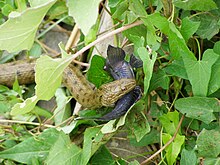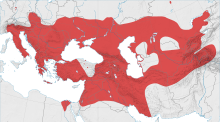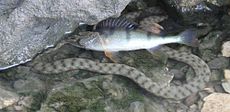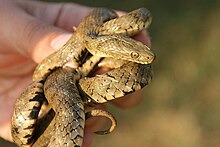Dice snake
 From Wikipedia the free encyclopedia
From Wikipedia the free encyclopedia
| Dice snake | |
|---|---|
 | |
| Scientific classification | |
| Domain: | Eukaryota |
| Kingdom: | Animalia |
| Phylum: | Chordata |
| Class: | Reptilia |
| Order: | Squamata |
| Suborder: | Serpentes |
| Family: | Colubridae |
| Genus: | Natrix |
| Species: | N. tessellata |
| Binomial name | |
| Natrix tessellata (Laurenti, 1768) | |
 | |
| Distribution of the Natrix tessellata | |
| Synonyms | |
| Coronella tessellata Laurenti, 1768 | |

The dice snake (Natrix tessellata) is a Eurasian nonvenomous snake belonging to the family Colubridae, subfamily Natricinae. It is also called water snake.[3]
Brief description[edit]


Females are bigger than males. Their typical size is 1.0–1.3 m (39–51 in) long. Their color may vary from greyish green to brownish or almost black, with dark spots on the back. The belly is sometimes vividly coloured in yellow or orange, with black spots, very similar to dice, hence the name.
Biology[edit]
Living mainly near rivers, streams and lakes, it frequently feeds on fish. Sometimes, it feeds also on amphibians such as frogs, toads, and tadpoles.
Classified as nonvenomous, N. tessellata produces a potent antihemorrhagin in its serum[4] and has been said to produce a neurotoxin through a gland in its mouth.[5] As a defence, it spreads a very bad-smelling secretion from its cloaca. Another defence mechanism is thanatosis, playing dead.
During the mating season (March–May), they congregate in large groups. Egg-laying is usually in July, and one clutch consists of 10–30 eggs. The young snakes hatch in early September.


Dice snakes hibernate from October to April in dry holes near the water.
Distribution[edit]
The dice snake is found throughout much of Eurasia: Afghanistan, Albania, Armenia, Austria, Azerbaijan, Bosnia and Herzegovina, Bulgaria, China, Croatia, Cyprus, Czech Republic, France, Georgia, Germany, Greece, Hungary, India, Iran, Iraq, Israel,[6] Italy, Jordan, Kazakhstan, Kyrgyzstan, Lebanon, Montenegro, North Macedonia, Pakistan, Poland,[7] Romania, Russia, Serbia, Slovakia, Slovenia, Switzerland, Syria, Tajikistan, Turkmenistan, Turkey, Ukraine, Uzbekistan, and Yemen. The species is also present in Egypt.
Research projects[edit]
Czech Nature Conservation Agency[edit]
The Dice Snake is considered Critically Endangered in the Czech Republic, mostly due to destruction of habitats and the introduction of an invasive species, the American mink. In order to combat this, the Czech Nature Conservation Agency began a project in 2007 to figure out what factors determine the distribution of the Dice Snake. The predictive model suggested that the most influential factors were watercourses and bodies, average annual temperatures, altitude, slope inclination, and precipitation seasonality. At the conclusion of the study, researchers proposed that the next route of study should be focused on areas that should but don't contain Dice Snake populations based on the predictive model. These areas might become the focus for conservation/migration efforts.[8]
Fluctuating Asymmetry in Urban Dice Snake Populations[edit]
Urbanization is one of the greatest reasons that habitats for Dice Snake populations are on the decline. As a result, some Dice Snake populations have been forced to live in artificial lakeside habitats. A study published in 2023 researched the effects of urban living on the Dice Snake and found that urban environmental factors influence the fluctuating asymmetry, body condition, and size of dice snake populations.
Fluctuating asymmetry (FA), a measure of developmental instability, was found to be significantly influenced by local environmental variables. Specifically, larger harbors were associated with poorer body condition in dice snakes. This correlation suggests that larger harbors may harbor higher pollutant concentrations or increased human disturbance, leading to adverse effects on snake health and fitness. Proximity to main roads was identified as a significant factor influencing the level of fluctuating asymmetry in dice snake populations. Snakes living closer to main roads exhibited higher levels of asymmetry, indicating potential negative effects of road-related factors on snake development and health.
The study concluded that conservation efforts should focus on mitigating the negative impacts of urbanization on dice snake populations. Strategies may include reducing pollutant release into the environment, exploring alternative road materials to minimize the adverse effects of roads, and implementing measures to reduce human disturbance in snake habitats.[9]
Population Bottlenecks and Resulting Loss of Genetic Variation[edit]
Another study in 2001 studied the effect of bottlenecks on the Dice Snake population when Dice Snakes were introduced into several lakes in Switzerland. A bottleneck on a population is "an event that drastically reduces the size of a population"[10]
The study followed two introduced populations, one that was serially bottlenecked and one that was only bottlenecked once. Both populations had much less allelic diversity and resulting heterozygosity (due to inbreeding) than populations that had never been bottlenecked, but the one that was serially bottlenecked displayed a greater severity of these conditions.
Scale anomalies were another factor that was studied during this project. Scale anomalies are often a sign of developmental stress, and the introduced populations had a greater frequency of scale anomalies than normal. The occurrence of scale anomalies correlated with the degree of bottlenecking and individual heterozygosity. Developmental stability, reflected in the ability to withstand environmental and genetic perturbations, is indirectly linked to individual fitness. Studies on other snake species indicate a negative relationship between scale anomalies and traits such as locomotion speed and growth rate, which affect survival.
Researchers argue that population decline should be prevented and large populations maintained in order to conserve allelic diversity and genetic variability. But the root problem of habitat destruction must be addressed as well. Habitat protection and restoration are crucial for protecting natural populations of Dice Snake. Demographic and genetic monitoring of populations can aid in detecting declines and assessing genetic variability. Introduction of new genes from different populations can enhance genetic variability, but careful selection of source populations is essential to avoid harming existing populations and outbreeding depression.[11]
Parasitic Threat[edit]
One of the most numerous populations lives in the vicinity of the ruins of Histria, in the Dobruja region, Romania. This population has been recently discovered to be threatened by a parasitic nematode of the genus Eustrongylides. Since 2005, the population from Histria has been receiving researchers' attention. For example, a joint Romanian–Swedish–Czech research program is focused on population biology studies and parasitic threats of this unique coastal population. An overview on Biology, Distribution and Conservation is given by Mebert (2011).[12]
References[edit]
- ^ Mebert, K.; Amr, Z.S.S.; Al Johany, A.M.H.; Aloufi, A.A.H.; Jiang, J.; Meyer, A.; Sterijovski, B.; Baha El Din, S.; Pleguezuelos, J.; Sá-Sousa, P.; Corti, C.; Ajtic, R.; Tuniyev, S.; Orlov, N.L.; Ananjeva, N.B.; Cogălniceanu, D.; Andrén, C.; Crnobrnja-Isailović, J.; Aghasyan, A.; Avci, A.; Tuniyev, B.; Lymberakis, P.; Wilkinson, J.; Üzüm, N.; Podloucky, R.; Kaya, U.; Vogrin, M.; Pérez Mellado, V.; Cheylan, M.; Nettmann, H.K.; De Haan, C.C.; Schmidt, B.; Lau, M.; Borkin, L.; Milto, K.; Golynsky, E.; Belouskova, A.; Rustamov, A; Nuridjanov, D.; Munkhbayar, K. (2021). "Natrix tessellata". IUCN Red List of Threatened Species. 2021: e.T157256A745071. doi:10.2305/IUCN.UK.2021-2.RLTS.T157256A745071.en. Retrieved 21 February 2022.
- ^ Boulenger, G.A. 1893. Catalogue of the Snakes in the British Museum (Natural History), Volume I. London. pp. 233-234
- ^ Guicking, Daniela; Joger, Ulrich; Wink, Michael (25 August 2009). "Cryptic diversity in a Eurasian water snake (Natrix tessellata, Serpentes: Colubridae): Evidence from mitochondrial sequence data and nuclear ISSR-PCR fingerprinting". Organisms Diversity & Evolution. 9 (3): 201–214. doi:10.1016/j.ode.2009.03.001.
- ^ Borkow, Gadi; Gutierrez, Jose Maria; Ovadia, Michael (December 1994). "A potent antihemorrhagin in the serum of the non-poisonous water snake Natrix tessellata: isolation, characterization and mechanism of neutralization". Biochimica et Biophysica Acta (BBA) - General Subjects. 1201 (3): 482–490. doi:10.1016/0304-4165(94)90080-9. PMID 7803481.
- ^ "Wildest Europe - Swimming Snake". www.facebook.com. Discovery Channel UK. Retrieved 2018-03-17.[unreliable source?]
- ^ Academy, Reptile (2024-04-06). "Natrix tessellata: A Comprehensive Review". לוכד נחשים - מוקד מחוז ירושלים (in Hebrew). Retrieved 2024-04-06.
- ^ Vlcek, Petr; Bartlomiej Najbar and Daniel Jablonski. (2010) First records of the Dice Snake (Natrix tessellata) from the North-Eastern part of the Czech Republic and Poland. Archived 2010-04-14 at the Wayback Machine Herpetology Notes 3:23-26
- ^ Chmelař, Jan; Civiš, Petr; Fischer, David; Frynta, Daniel; Jeřábková, Lenka; Rudolfová, Veronika; Rehák, Ivan (28 December 2023). "Protecting isolated reptile populations outside their main area of distribution: a predictive model of the Dice snake, Natrix tessellata, distribution in the Czech Republic". Biodiversity Data Journal. 11. doi:10.3897/BDJ.11.e114790. PMC 10767748. PMID 38188184.
- ^ Mészáros, Boglárka; Bürgés, József; Tamás, Mónika; Gál, Blanka; Bohus, Attila; Schmera, Dénes (December 2023). "Effects of the urban environment on the developmental stability, size and body condition of dice snakes (Natrix tessellata) living in artificial lakeside habitats". Ecological Indicators. 156: 111117. doi:10.1016/j.ecolind.2023.111117.
- ^ "population bottleneck". Scitable. Nature Education.
- ^ Gautschi, Barbara; Widmer, Alex; Joshi, Jasmin; Koella, Jacob C. (September 2002). "Increased frequency of scale anomalies and loss of genetic variation in serially bottlenecked populations of the dice snake, Natrix tessellata". Conservation Genetics. 3 (3): 235–245. doi:10.1023/A:1019924514465.
- ^ Mebert, Konrad (2011). The Dice Snake, Natrix Tessellata: Biology, Distribution and Conservation of a Palaearctic Species. DGHT. ISBN 978-3-9812565-4-3.[page needed]
